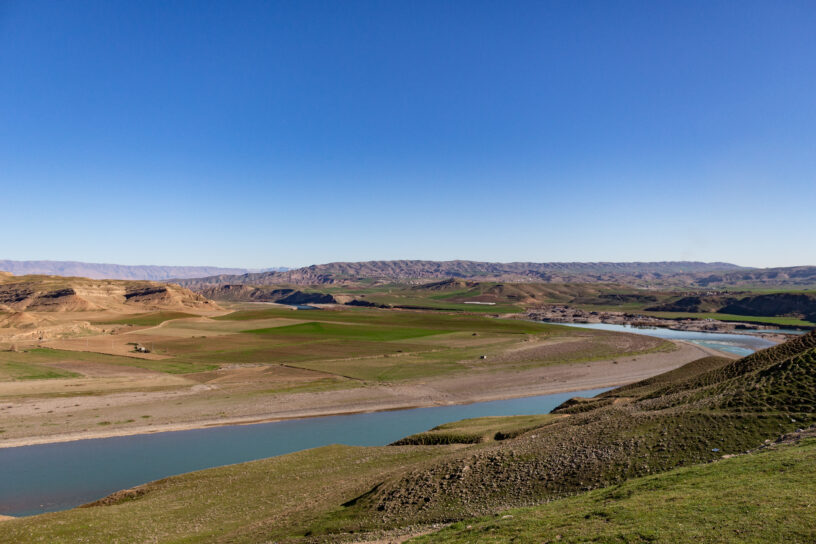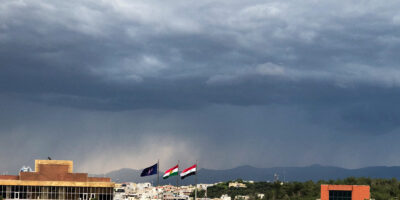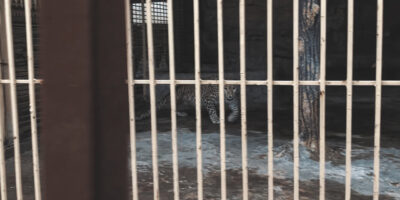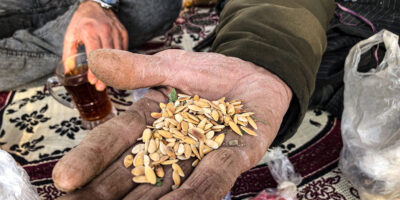CHAMAKAY KHWARU, Kurdistan Region – On a rise overlooking the Greater Zab River sits Chamakay Khwaru’s graveyard. A few of the graves are marked with slabs of stone that are inscribed, but most are simple, well-worn rocks with no markings, as is custom here.
My guide is 51-year-old Akram Rashid Majid. A father of six sons and one daughter, he’s a tall, slim man dapperly dressed in a blue, traditional Kurdish outfit of loose pants, twisted cumberband, and checkered scarf on his head. A tan jacket to ward off the nippy winter air completes the outfit. He strides through the graveyard, pointing out the resting places of his family members and friends – his father, his grandfather, a cousin, a neighbour who was killed in a dispute that also left Majid wounded, and a man who was struck by lightning, his grave now visited by people who believe he was holy.
Majid constructed the fence that surrounds the graveyard to keep animals out. A family living next to the cemetery has found another use for the fence, using it as a laundry line to dry their colourful shirts and dresses. People in the village and their families who have moved away come to the graveyard every week to pay their respects to their loved ones. The place where their ancestors lie is very much the heart of the village.
At the edge of the graveyard closest to the river are six small stones in a row. They mark the graves of Majid’s children who died of illnesses when they were young.
“They’re about to kill the rest of my children,” he said. He envisions the water of a planned dam inundating the graveyard and his home.
Chamakay Khwaru village has lived through the Ottomans, Iraqi kings, Baathist dictators. Through it all, the people who live here have worked the soil, loved their families, enjoyed tea and laughs with their neighbours, and buried their dead, generation after generation. Now, everything might be taken away from them.
For years, they have heard rumours that a dam will be built just upstream from their homes, at Mandawa, 40 kilometres north of Erbil. Chamakay Khwaru was named in a Facebook page of a local news site that, citing an engineer, listed 14 villages on both sides of the river and all home to the Surchi tribe that would be flooded if the dam is built.
“Noone has come officially to inform us about it,” said Muzafar Hamza, mukhtar (village chieftain) of Chamakay Khwaru. An agricultural engineer came once and visited some of the families, but not all, asking about the farmland they owned, registering it presumably in preparation for compensation of lands that would be inundated by the dam.
The village consists of some 100 homes collected on a small crest overlooking the Greater Zab River. The banks of the river are given over to farmland that also wraps around the village. One rumour is that the whole village will be flooded; another is that all but the two houses furthest up the slope will be lost to the water. One man said he heard the water would reach just to the roof of his neighbour’s house down the rise from his own home. It’s all speculation, rumour, and worry.
“We don’t know what’s going to happen. We don’t know what their plan is,” said Hamza.
Dams shore up Kurdistan’s climate change strategy
Mandawa is one of three new dams for which the government last April announced final decisions had been made about their construction. The other two are Delga, in the Raparin administration, and Bakirman, in Duhok. Building these three dams “will be a strong step towards stability of water security and increasing water resources in the Kurdistan Region,” Minister of Agriculture and Water Resources Begard Talabani said at the time.
The government has signed a Memorandum of Understanding for Mandawa and three other dams with PowerChina, a Chinese state-owned construction company.
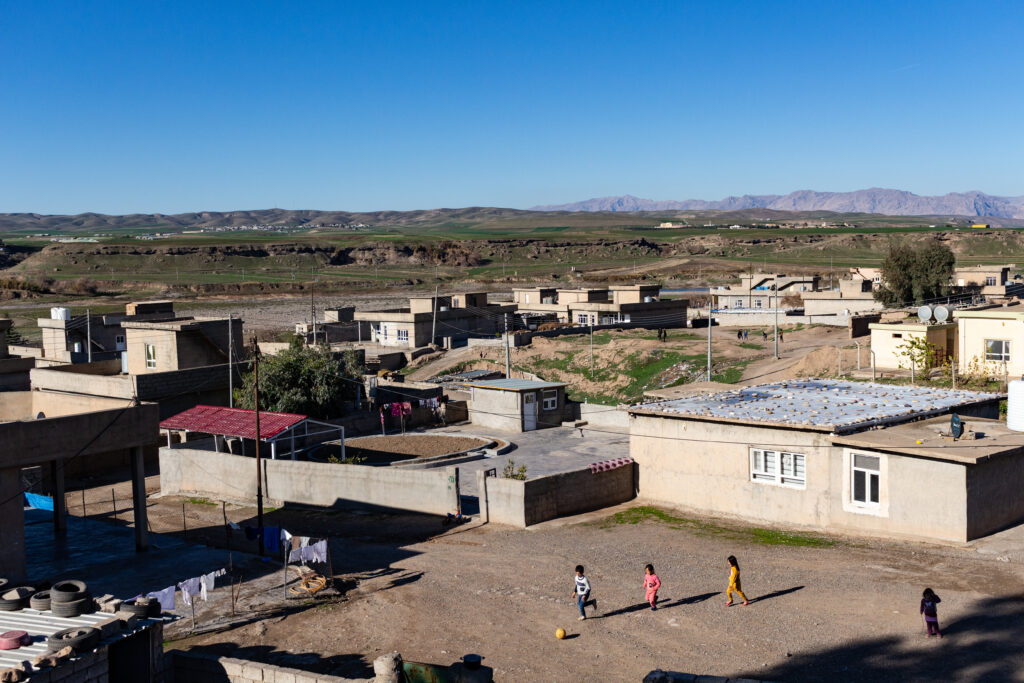
The plan for Mandawa is a large 54.5 metre high dam with a storage capacity of 330 million cubic metres, according to information from the Kurdistan Regional Government’s (KRG) directorate of dams. At full capacity, it will create a 30 square kilometre lake, provide drinking water for nearby Erbil city, and irrigate some 108,000 dunams of land. It will also generate 99 megawatts of electricity. Construction will cost an estimated $800 million.
Dams are central to the government’s water management strategy as it looks to tackle the problems induced by climate change, including water, food, and energy security.
The current cabinet of the KRG “has made significant strides in enhancing water availability across the region. Their primary focus has been the construction of dams and reservoirs, with the completion of four dams and ongoing work on 13 additional ones. The combined cost of these projects exceeds 553 billion Iraqi dinars [$422 million],” a government statement proclaimed last October.
The government is keen to promote its action on dams as a success of the current administration. Its social media accounts frequently share images and videos of dams under construction: Khans dam in Duhok, Gomaspan in Erbil, Aquban in Shaqlawa, Semel and Sbnadu in Duhok. Laying the cornerstone for a dam in Erbil province last summer, KRG Prime Minister Masrour Barzani said the structure will “become a symbol of life.” The pro-government magazine Kurdistan Chronicle hailed the KRG’s dam-building strategy as one that will “secure the future of its people.”
The future of the Kurdistan Region is one that will in large part be dictated by climate change. The area is already suffering from water shortages, and the problem is likely to get much worse.
In the Region’s Garmiyan area, shepherds have had to move their flocks further north in search of water. Erbil needed government funds to bail it out of a drinking water crisis. Villages in the Amedi area of northern Duhok are emptying out because of water shortages.
Two years ago, the director general of water at the agriculture ministry said that half the villages in the Kurdistan Region are at risk of water shortages, rivers are low, and groundwater reserves are down.
The problem is worse in the rest of the country. Last summer, Iraq’s freshwater reserves were down by half from the year before, bringing them to “the lowest in the history of the country,” a spokesperson for the federal water ministry told Rudaw. The Norwegian Refugee Council predicts that about a quarter of Iraq’s available freshwater will be depleted within 15 years because of climate change.
The Greater Zab is one of the healthiest rivers in the country, partly due to the fact that it is not dammed, yet. It runs roughly 375 kilometres from its source near Turkey’s Lake Van, through the Kurdistan Region, and enters the Tigris at al-Safina, roughly 45 kilometres south of Mosul. It accounts for about a third of the flow of the Tigris that reaches Baghdad.
It is a “very clear river… there is no dam on Greater Zab, so that means the water is very clear and the system is not disturbed,” said Jehan Mohammed Sheikhsuleimany, an engineer specialising in water and the environment who teaches at Erbil’s Salahaddin University and has studied drought vulnerability in the Mandawa area.
The flow of the river naturally changes with the season – peaking with the spring rains and snow run off and ebbing during the dry summer and autumn – but its volume has been slowly declining for decades. Precipitation, blue water (water found in rivers, lakes, and underground aquifers), and green water (water in the soil and plants) have all “significantly” decreased between 1980 and 2010, found a 2016 study on the impact of climate change on the Greater Zab.
The study predicted that “the catchment will be drier in the near and distant futures.”
This is backed up by the limited available data from the KRG’s directorate of dams, which shows a steady decline in the Greater Zab’s volume.
In Chamakay Khwaru, they can see changes in the river. The water always recedes in the hot, dry summers, but the lows are getting lower and streams that feed the river are drying up. These streams once watered pomegranate trees that made the village famous, but now the trees are dying.
Are dams the best solution?
Dams radiate power. They are symbols of dominance over nature, defying the law of gravity to hold back a river, controlling access to the very essence of life.
As control of water resources becomes even more important during the climate crisis, many governments are building dams. Turkey’s GAP project consists of 22 dams, including the flagship Ilisu. China is building the Zangmu superdam on the Brahmaputra River. Ethiopia constructed the Grand Renaissance Dam on the Nile.
It is hoped that building dams in the Kurdistan Region will fulfil multiple purposes, including retaining water for domestic, agricultural, and industrial use, recharging groundwater reserves, generating hydropower, and creating tourism destinations.
But the cons of dams far outweigh the pros and the debate over their use is growing.
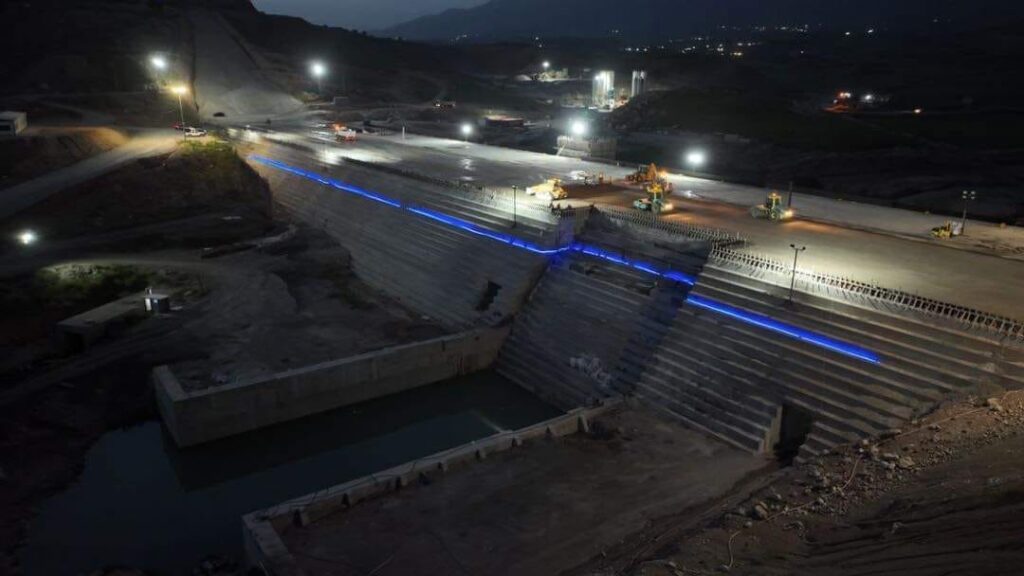
Dams are expensive, both to build and maintain. By blocking the flow of water, they destroy the health of rivers and surrounding ecosystems at the dam site and downstream. They emit significant volumes of greenhouse gases, including one of the most potent – methane. Dams upstream in the Tigris-Euphrates basin contribute to increasing numbers of dust storms in southern Iraq.
Installing power turbines in dams ties electricity generation to an unstable resource. The Kurdistan Region’s power grid is already only able to meet roughly half the demand. Depending on hydropower could backfire in the long run when there is not enough water to run the turbines.
Last spring, the government broadcast the news of its dams and reservoirs filling up after heavy rains, but the increase only brought Dukan dam up to 38 percent capacity. In five of the past six years, both Dukan and Darbandikhan dams were far below capacity, with Dukan often less than half full and Darbandikhan hitting 60 percent. The two dams are the largest in the Kurdistan Region. In 2021, water levels were so low that electricity generation at Darbandikhan fell to just 15 megawatts.
Dams are also major sources of evaporation. Iraq loses eight billion cubic metres of water annually to evaporation. That is about 10 percent of the country’s total renewable water resources. And as water in dam reservoirs evaporates, the quality of the remaining decreases because of rising salinity.
Because of the myriad of problems that come with dams, there is a growing trend in Western nations to remove the structures. As many as 5,000 dams have been torn down in Europe and 1,700 in the United States, driven by cost and safety concerns, as well as environmental factors. “The dams that were once proudly built to facilitate economic development are now criticised for becoming sources of unprecedented environmental and socio-economic problems,” wrote the authors of a 2021 study of dam removals in the US.
Some $450 million in funding has been secured for the removal of a dam in California to restore salmon spawning grounds on the Klamath River.
Engineering and water management experts I spoke to believe that the Kurdistan Region should build dams, but they criticised how the government is going about it.
Nadhir al-Ansari, a water resource engineer at Lulea University of Technology in Sweden, co-authored the report on the impact of climate change on the Greater Zab River. He said that while the river’s volume is dropping, it still remains relatively high compared to other rivers in the region. “Once the dam is constructed there are several ways to reduce evaporation from its reservoir. In view of this it is better to build a dam to minimise the water shortage problem,” he said, if the government can overcome its financial problems that are holding back the Mandawa project.
Engineer Sheikhsuleimany also supports the construction of dams. “Building dams is very essential for Kurdistan, as our region of Kurdistan is considered the source of water for the entire Iraq due to the amount of precipitation and the location… The question is what type of dam is required,” she said.
She recommends building small and medium sized dams, under 15 metres high. This would minimise problems of evaporation and displacing whole communities, and would cost much less.
Sheikhsuleimany would also like to see the government turn its focus to issues of management, rather than dams.
“The Kurdistan Region is missing awareness among people to adopt reduce, repair, reuse, and recycle concepts, clear management of water resources, and new technologies in irrigation. Only building dams will not solve the problems,” she said. “We are not respecting our water. We have very good quality water. We have good rain. But, you know, losses are too much. There is a clear mismanagement of our water resources.”
Environmentalists despair at the thought of a dam on the last free-flowing river in the Kurdistan Region. “There’s a lot of negative impacts on our biodiversity and ecosystem, and, of course, local people, displacing people, erasing our culture,” said Waterkeeper Nabil Musa.
“We should let the river flow,” he said.
Akram Ahmed founded the KRG’s dam directorate in April 2007 and served as its director for 15 years until he retired in January 2022. He acknowledges the environmental concerns about dams, but said the need for water is paramount. “We need to have a clean environment, try to tell people to have a green area, not to pollute the water…. But in all cases, we need to have enough water… Water is a part of national security,” he said.
‘Do you think the government will just drown us all?’
The 14 villages that will be flooded by Mandawa dam lie along both banks on a straight stretch of the Greater Zab between two s-curves. Here, life is governed by the seasons and farmers work the same soil as their fathers, grandfathers, and great-grandfathers, practising traditions that have been passed from generation to generation.
Winter is the quiet season. Most of the fields are filled with wheat. The long, cold months fed by winter rains will yield a good harvest.
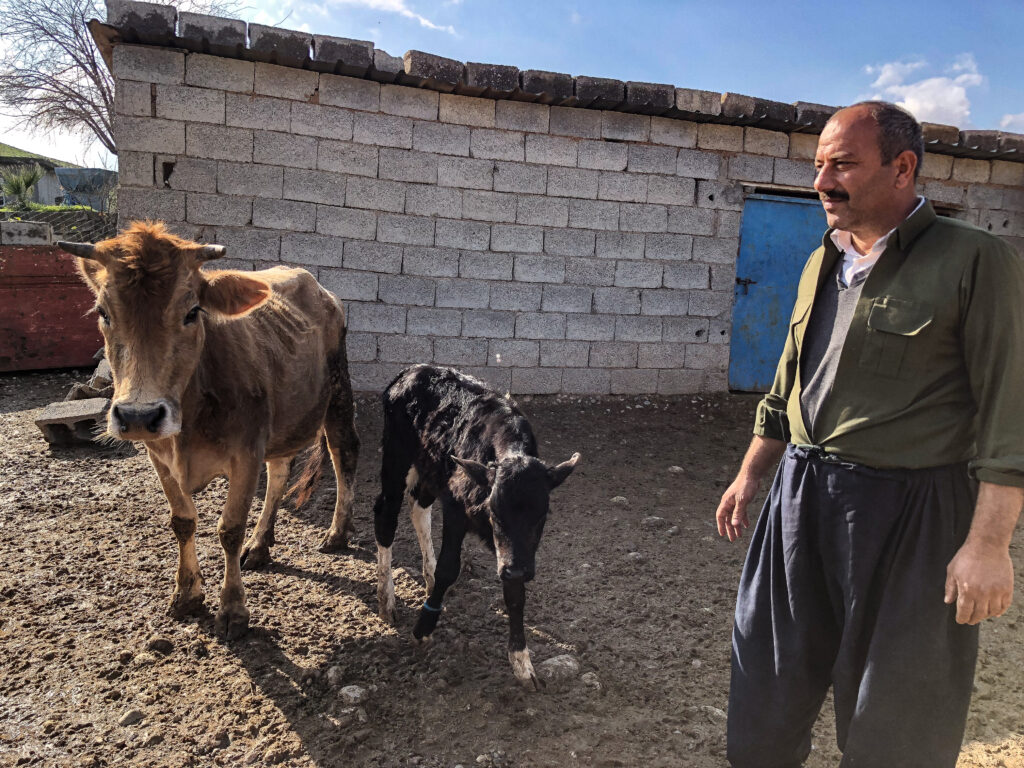
In March, the river swells with the spring rains and melting snow. The farmers return to work in the fields where there is no wheat, planting watermelon, cucumber, tomato, okra, green beans. More vegetables are grown in greenhouses. The wheat is harvested in June, after which a second crop of vegetables can be planted. In August, the farmers can send more than 20 tons of cucumber to Erbil every day.
On hot summer days, men, women, and children find cool relief in the river, jumping in and swimming across the water.
In the autumn, it is time to pick fruit from the trees – pomegranates and peaches – and then plant the wheat and hunker down for winter, waiting for the storks to return in February, a harbinger of spring and the time to return to the fields.
Today’s farmers have the advantage of electricity and irrigation, and they grow more vegetables than the tobacco that their parents tended, but life still moves to the beat of the seasons.
It is a way of life that will be drowned if the government goes ahead with its plan to build a dam.
Omar Yusuf was born on these banks of the Greater Zab River in Chamakay Khwaru 43 years ago. A soft-spoken man who cares for his cows with a gentle hand, he took a break from tending his work to talk to us about life in the village where he has lived every day except for a few years when he was a child.
On Christmas day in 1988, Saddam Hussein’s armed forces destroyed Chamakay Khwaru, razing it to the ground and forcing the villagers to flee. Yusuf and his family went to Erbil. After the Kurdish uprising in 1991 that was supported by the internationally-imposed no-fly zone that gave Kurds badly needed breathing space under Saddam Hussein, they returned to their village and rebuilt their community with their bare hands.
“This is the lifestyle that we want to live – caring for our livestock and farming… We don’t like the city,” Yusuf said, recalling the few years of his youth when he lived in Erbil. He and his cousins own 80 acres of land that they farm.
As we chatted, his neighbours, whose hands were black with grease as they repaired a tractor engine, chimed in with the occasional comment and more friends and relations wandered into the yard. With every new arrival, young boys would be sent to grab plastic chairs to add to the growing circle. When they weren’t fetching chairs, the boys took up posts on the outer edge of the circle, mimicking the postures of their fathers and uncles, the next generation learning the lifestyle of the village.
This is the fourth generation that has grown up together. Their physical and emotional wealth and well-being are tied tightly to their village and their land, their soil. They cannot envision a happy, prosperous life for their children and grandchildren if the village is destroyed and their farmland is drowned.
“We’ve been living here forever,” said Majid. “I have enough land, I have enough work in the area to be able to provide life for my great, great grandchildren. But if the government kicks us out of here, what will they give me?… What we’ve built, it could be beneficial for the next 10 generations of our children. How can you compensate that? Can they compensate the next 10 generations who come after us? No, they won’t. But we can’t do anything about it.”
How do you calculate compensation? How much is a life, a home, a lifestyle, a future worth? Will compensation cover what would have been future income from the drowned land? Will it cover the mortgages that many people in the village took out on their houses a few years ago to fund some rebuilding?
The office of the minister of agriculture and water resources did not respond to requests for an interview for this article.
“We own the land,” said Omar Yusuf. “If they don’t compensate us, we won’t lift our feet from here. Do you think the government will just drown us all? They can’t.”
Lessons from Iran
Iran’s experience with water management is a useful comparison for Iraq. Both countries have large, arid expanses in the south and water-rich, mountainous areas in the north. After the Islamic Revolution in 1979, Iran went on a dam building spree as part of its plan to be self-sufficient in water and agriculture. It built some 600 dams in a four-decade span. But today, the country is water-starved. Its groundwater reserves are depleted and its rivers are drying up. Most summers, protests break out because of a lack of water.
The many dams are contributing to the problem, with rates of evaporation accelerating as global temperatures rise. Last summer, water reserves in Iran’s nine most important dams were below 20 percent and more than 85 percent of its reservoirs were empty. Its groundwater reserves have plummeted, overused on thirsty fields. Without enough fresh water, Tehran is now looking to the sea, spending billions of dollars on desalination.
So where did Iran go wrong?
Its water strategy was too focused on dams, according to Ali Hassanli, an environmental engineer specialising in water management and climate change. He has taught at Iran’s Shiraz University and the University of Kurdistan-Hawler, and is now at the University of South Australia.
“Iran has constructed many dams but still suffers from water challenges and dam construction has not helped enough, since sustainable use of scarce water hasn’t been in its development plans,” he said.
Even 600 dams are not enough if waste and mismanagement persist.
According to environmental journalist and consultant Peter Schwartzstein, Tehran built dams to look like it was accomplishing something. “Vitally, for governments – particularly in Iran – that have sometimes lacked legitimacy in their peoples’ eyes, these big, tangible structures are also much more visible illustrations of state performance than unsexy piecemeal improvements to water networks – and so favored by approval-seeking politicians, and occasional gambits in corruption-riddled political systems,” he wrote in a paper for the Wilson Center.
Hassanli believes there are a score of other less costly measures that should be prioritised instead of dams in the Kurdistan Region for truly effective water management: “The more environmental and sustainable solution could be improving community knowledge about efficient use of water, ecological measures, conservation measures of watersheds, reuse of wastewater, extending plants with less water requirements and the use of intensive agriculture to improve water productivity.”
Mismanagement of water resources in the Kurdistan Region is a problem frequently raised with experts – those working within the government’s water directorates, academics at the region’s universities, and civil society activists. The government’s own assessment is that some 50-60 percent of distributed drinking water is lost because of leaks or illegal connections to the public water mains, despite the utility being provided at rates so low it is nearly free.
Ahmed, the retired head of the KRG’s dam directorate, believes the region’s water portfolio is lacking proper management from top to bottom. “Management starting from water harvesting up to waste water treatments to use water again, this is not available up to date,” he said, pointing to the political parties as part of the problem because they appoint people to important posts and then oblige them to follow the party line.
“People who work in the dams, they have to be the decision-maker and not listening to other leadership,” said Ahmed.
‘We are very, very angry’
Like in Iran where dams are symbols of the regime’s power and industry, in Iraq and the Kurdistan Region, dams are about much more than just water. They are also pawns in political games and military machinations.
Two of Iraq’s largest dams are in the Kurdistan Region. Dukan dam, constructed on the Lower Zab River, opened in 1959 and Darbandikhan dam, on the Sirwan River, opened two years later in 1961. They have played a role in efforts of successive governments in Baghdad to suppress restive Kurds, according to Ariel Ahram, a professor at Virginia Tech’s School of Public and International Affairs who has written a paper that delves into historical records to shine a light on the environmental aspect of the Anfal genocide committed against Kurds in northern Iraq.
The dams were built to support modern agriculture and industry and they forced villagers to give up rural life and move into cities as Baghdad used development as “a tool for military pacification,” wrote Ahram.
Once the dams were built, protecting them justified military measures. When Iran and Kurdish rebels launched their first major offensive into Iraq in 1983, Saddam and his aides feared they would attack the dams.
“If Iranian forces made it to the dams of the rivers in the north, they would gain a major advantage. Those dams were critical, because if the Iranians were to destroy them, the central and southern areas [of Iraq] would be flooded. From the Iranian perspective, this would represent a great achievement,” Ra’ad Hamdani, a general in Iraq’s Republic Guard, told American interviewers, as cited by Ahram.
Baghdad responded to the threat with its first use of poison gas.
“The geography of the Anfal campaigns overlay the areas where hydrological remediation had been most intensive in the prior decades,” wrote Ahram.
In the 1980s, Iraq began building a third large dam, Bekhme on the Greater Zab River, that would flood lands belonging to the rebellious Barzani tribe. Construction stopped in 1991 with the Gulf War and never resumed because Saddam’s forces pulled out of the north, giving control to the Kurds led by the Barzanis’ Kurdistan Democratic Party (KDP).
The KRG began big projects, not always to great effect, to improve neglected infrastructure when it was flush with cash after it began independently selling its oil in 2014. “The region is scattered with examples of abandoned, failed or poorly designed infrastructure projects, and dams are no exception,” the Save the Tigris campaign wrote in a 2020 report that notes that 245 dams have been proposed by the KRG in the past decade.
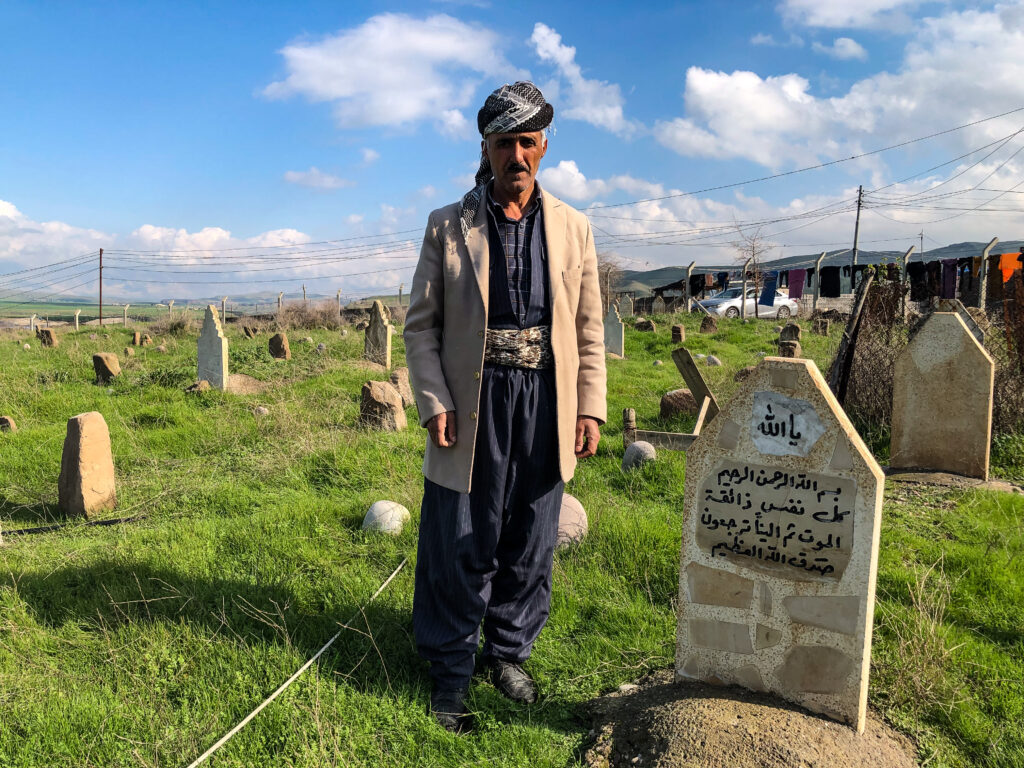
In Chamakay Khwaru, they feel steamrolled by a government that does not listen to them.
“We are very, very angry,” said mukhtar Hamza. “Imagine being kicked out of your house. Even when we lost our village before, it was burned by Saddam, but we still had hope and we came back and we built it again. But this time if it’s going to be under the dam, we will never be able to get it back again. So people are angry. Everybody is very angry.”
“We will lose everything because it’s like someone being kicked out of their house and they have to leave everything and go. We will lose our social connections. Our kids will grow up not knowing each other because each one of us will have to relocate to a different area. It will be like a funeral forever because we will never be able to come back here. This will be a dam forever, we cannot change that. It will be everything that we will lose – mentally and physically,” he continued.
When the rivers are dammed, the very lifeblood of a nation is caged. Akram and his relatives and neighbours compared life outside of their village to being imprisoned, just as the waters of the Greater Zab would be behind the concrete of Mandawa dam. The last time they had to leave their village, they were fleeing genocide, but returned and rebuilt because of the strength of their connection to the soil.
“Spending one day in a house in the village is worth more than all of Erbil… They want to change the course of our life,” said Akram.
“I’d rather be shot right here than be made to move from here,” he added, to a chorus of agreement around the circle of friends and family.

